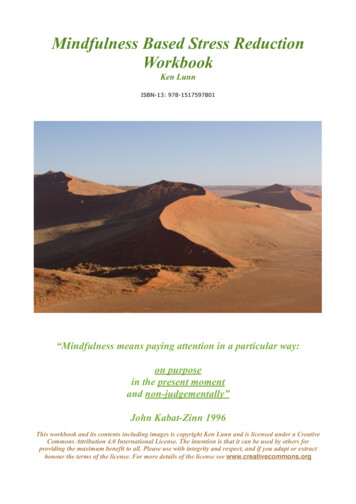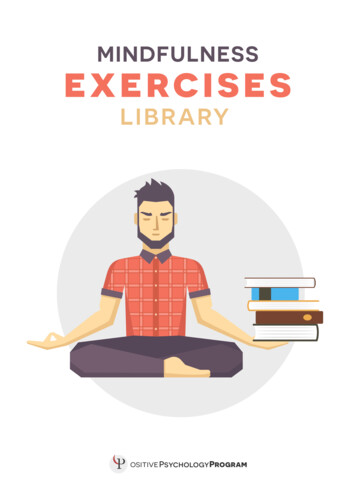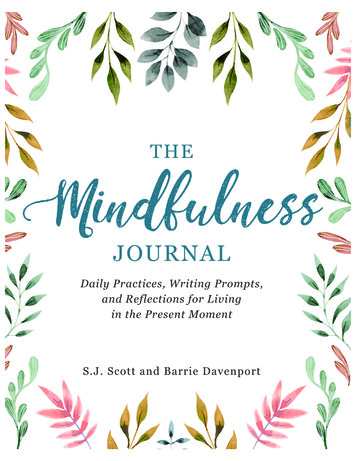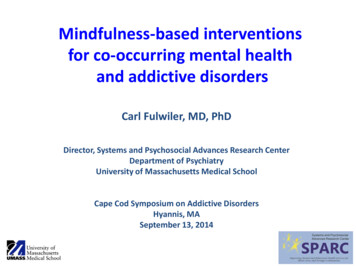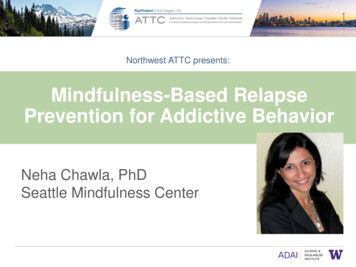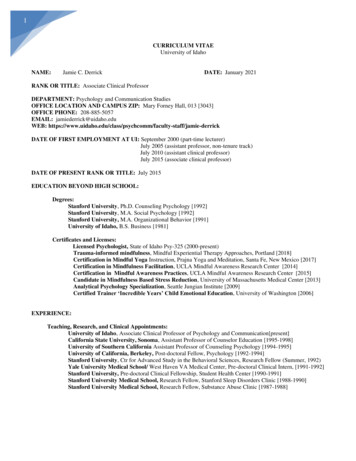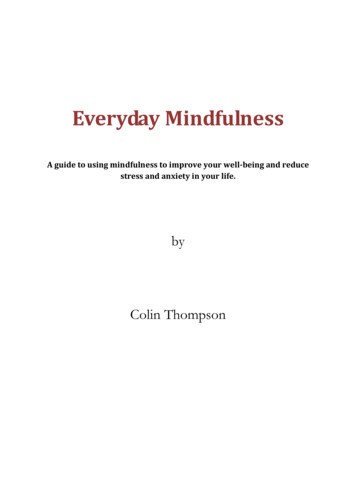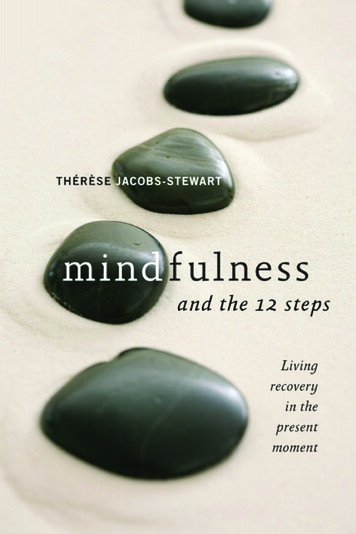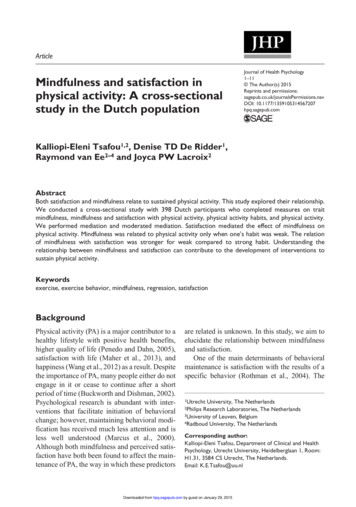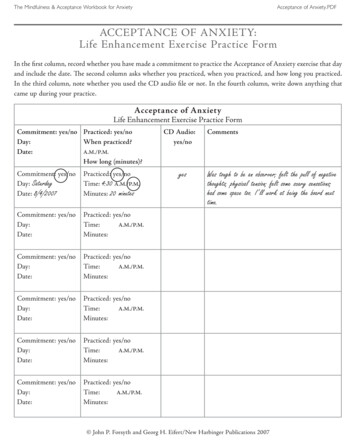
Transcription
The Mindfulness & Acceptance Workbook for AnxietyAcceptance of Anxiety.PDFAcceptance of Anxiety:Life Enhancement Exercise Practice FormIn the first column, record whether you have made a commitment to practice the Acceptance of Anxiety exercise that dayand include the date. The second column asks whether you practiced, when you practiced, and how long you practiced.In the third column, note whether you used the CD audio file or not. In the fourth column, write down anything thatcame up during your practice.Acceptance of AnxietyLife Enhancement Exercise Practice FormCommitment: yes/no Practiced: yes/noWhen practiced?Day:Date:A.M./P.M.How long (minutes)?Commitment: yes/noDay: SaturdayDate: 8/4/2007Practiced: yes/noTime: 4:30 A.M./P.M.Minutes: 20 minutesCommitment: yes/noDay:Date:Practiced: yes/noTime:A.M./P.M.Minutes:Commitment: yes/noDay:Date:Practiced: yes/noTime:A.M./P.M.Minutes:Commitment: yes/noDay:Date:Practiced: yes/noTime:A.M./P.M.Minutes:Commitment: yes/noDay:Date:Practiced: yes/noTime:A.M./P.M.Minutes:Commitment: yes/noDay:Date:Practiced: yes/noTime:A.M./P.M.Minutes:CD Audio:yes/noyesCommentsWas tough to be an observer; felt the pull of negativethoughts, physical tension; felt some scary sensations;had some space too. I’ ll work at being the board nexttime. John P. Forsyth and Georg H. Eifert/New Harbinger Publications 2007
The Mindfulness & Acceptance Workbook for AnxietyBuilding Your Life Compass.PDFExercise: Building Your Life CompassWe’ve broken this exercise up into four easy steps. Referring back to your Valued Directions Worksheet will make building yourLife Compass easy. The Life Compass appears at the end of the exercise.Step 1: Focus on Life Domains You Find ImportantYou’ll notice that there are two small, blank boxes attached to each value in the Life Compass below. These boxes are for ratingeach value in two different ways: how important the value is to you (“i” is for “importance”) and how often you have actuallymoved in that direction over the past two weeks (“a” is for “action”).Let’s start with the importance rating. Go back to the Valued Directions Worksheet and copy your importance ratings intothe “i” box connected to each value.Step 2: What Are Your Intentions?Write a brief intention statement in those value boxes you rated as either moderately important (1) or very important (2). Youcan start by going to the intention statements on the Valued Directions Worksheet. We’ve found that these statements tend tobe one or two sentences long. We suggest that you boil these down to a shorter statement that will fit into the box of the LifeCompass so that you’ll be able to remember the intentions more easily when you’re in the grip of WAFs. Do this for all areasyou rated 1 or 2. If you have three or more areas that you rated as very important (2), you might want to focus on those andwrite in an intention for only those areas. Remember, intentions are statements about how you would like to live your life in thatarea—what is most important to you. Now go ahead and write your intentions in each box.Step 3: Are You Doing What Matters to You?After you’ve finished writing down your intentions, please think about your activities in the past two weeks. Are your actionsconsistent with your intentions in each area? We call these activities “your feet.” So, were you doing things consistent with theintentions you just wrote down? For each intention, rate how often you’ve done something to move you toward your importantvalues during the past two weeks. Use the following scale for your ratings: no action (0), one or two actions (1), three or fouractions (2), and five or more actions (3). Write your ratings in the “a” (actions) box next to the “i” box that’s connected to eachvalue. We’re not asking about your ideal in each area or about what others may think of you. Just rate how actively you’ve beenliving out your intentions over the past two weeks.Now go back and look at your intentions and actions. How well do they match up for each value domain you rated asimportant to you? Take stock here. Look for areas where the “i” number is larger than the “a” number. This mismatch meansthat you’re not living your life as you want to live it. For instance, if you consider family very important (say, “i” is rated a 2) andyour action rating is low (“a” is rated a 0 or 1), you’re living a life that is quite different from the one you want. If you’re like mostpeople with anxiety problems, you might find discrepancies between your importance and action ratings.Step 4: What Stands in Your Way?Discrepancies between your intentions and actions in valued areas are often related to barriers. Barriers are anything that standsin the way of you living out your values. Go back to each value area that’s important to you and examine what exactly standsin the way. Perhaps it is a fear of a panic attack or other intense feelings; thoughts about being overwhelmed, embarrassed, orexposed; intrusive unwanted thoughts that seem to show up out of thin air and invade your mind; painful images or memories;specific worries about what will happen if you move in that direction; thoughts about failure, incompetence, or inadequacy; orother worries and doubts. Whatever the barriers may be, just write them down (in a word or two) in the signs on your LifeCompass. These signs are the barriers between you and your values. John P. Forsyth and Georg H. Eifert/New Harbinger Publications 2007
The Mindfulness & Acceptance Workbook for AnxietyWork/careerBuilding Your Life n/leisurei i a i a i a Education/learningCommunity life/environment/naturei a i Spiritualitya Friends/social lifeFamily of origini a Health/physical self-carea i i a i a John P. Forsyth and Georg H. Eifert/New Harbinger Publications 2007a
The Mindfulness & Acceptance Workbook for AnxietyCosts of Anxiety Management.PDFExercise: Costs of Anxiety Management1. Interpersonal costsSummarize the effects of struggling with your WAFs on your relationships. Have friendships changed or been lost?Have family members been alienated? Do they avoid you, or do you avoid them? Have you lost a marriage or romanticrelationship due to worry, anxiety, or fear? Or have you missed out on new social bonds because of fear, dread, oran unwillingness to trust because of past trauma? Are you unable to engage your roles as a spouse, partner, or parentbecause of those pesky WAFs?2. Career costsSummarize the effects of struggling with anxiety on your career. Have you ever quit or been fired from a jobbecause of attempts to get a handle on your anxiety and fear? This includes being late, being less productive, missing daysof work, being unable to travel, avoiding tasks where WAFs might show up, skipping out on business and social interactions with colleagues and customers, or procrastination. Has a boss or have coworkers commented on your poorperformance because of your anxiety management efforts? Have those efforts affected your school career (relationshipswith teachers, administrators)? Have they resulted in unemployment or being on disability or welfare?3. Health costsDescribe the effects of managing your worry, anxiety, and fear on your health. Do you tend to get sick often? Doyou have difficulties falling asleep and staying asleep? Do you sometimes ruminate and stew over anxiety and worry tothe point of feeling sick or keyed up? Do you avoid taking care of your health because of your WAFs (e.g., avoid goingto the doctor, having tests done, visiting a dentist)? Do you avoid exercise because it might bring on your WAFs? Haveyou spent quite a bit of time in the doctor’s office or emergency room for your WAFs?4. Energy costsOutline how managing your anxiety has affected your energy. Do those efforts sometimes exhaust you? Have youput time and energy into disappointing efforts at WAF control? Are you often engaged in mental planning and fact-findingin an effort to ward off or minimize your WAFs? Do you waste mental energy on worry, stress, fretting over distractions, John P. Forsyth and Georg H. Eifert/New Harbinger Publications 2007
The Mindfulness& Acceptance Workbook for AnxietyCosts of Anxiety Management.PDFchecking, and negative thinking? Have you experienced difficulties with memory or concentration? Have your attemptsto manage anxiety left you feeling discouraged, fatigued, or worn out?5. Emotional costsWhat have efforts to get a handle on anxiety cost you emotionally? Do you feel sad or depressed about your WAFs?Have you tended to be on edge, perhaps exploding in anger in times of stress? Do you carry regrets and guilt becauseof what you have done or failed to do because of your WAFs? How do regrets about your WAF episodes affect youemotionally? Do you feel depressed or hopeless when your efforts to control anxiety aren’t working? Do you feel asthough life is passing you by?6. Financial costsHow much money have you spent on managing your WAFs? Consider money you’ve spent on psychotherapy foryour WAFs and related difficulties (e.g., depression, anger, alcoholism). How about medications, money spent on doctor’s visits, or the costs for anxiety books, tapes, DVDs, or seminars? See if you can come up with a reasonable estimateof these monetary costs. You can include costs due to disability, lost wages, and missed work because of your WAFstoo.7. Costs to freedomHow have your efforts to control WAFs limited your ability to do what you want to do? Can you drive near andfar, with or without others? Can you shop, take a train or plane, or go for a walk in your neighborhood, the park, amall, or a forest? Do the WAFs keep you from trying new foods, new activities, new forms of recreation, experiencingyour dreams, and doing what you care about? Consider also whether your WAF management strategies keep you fromdoing what you already enjoy doing. John P. Forsyth and Georg H. Eifert/New Harbinger Publications 2007
The Mindfulness & Acceptance Workbook for AnxietyFEEL* Bodily Discomfort Form.PDFFEEL* Bodily Discomfort FormDate:Time:0123456789Low 0)Anxiety Level(0–10)Willingness toExperience(0–10)A.M./P.M10ExtremeStruggle withExperience(0–10)Avoidance ofExperience(0–10)Staring at a spotSpinningHead between legsShaking headBreath holdingBreathing through strawBreathing fast/deeplyFast walkingJogging in placeClimbing stepsStaring at self in mirrorOther* Feeling Experience Enriches Living John P. Forsyth and Georg H. Eifert/New Harbinger Publications 2007
The Mindfulness & Acceptance Workbook for AnxietyFEEL* Thought and Imagery Form.PDFFEEL* Thought and Imagery FormDate:Time:0123456789Low 0)Anxiety Level(0–10)Willingness toExperience(0–10)A.M./P.M10ExtremeStruggle withExperience(0–10)Avoidance ofExperience(0–10)Demoting mind playBubble wandKind allowing imagesCandle of forgivenessLeaves on streamOtherOther* Feeling Experience Enriches Living John P. Forsyth and Georg H. Eifert/New Harbinger Publications 2007
The Mindfulness & Acceptance Workbook for AnxietyLiving in Full Experience—The Life Form.PDFLIVING IN FULL EXPERIENCE—THE LIFE FORMA Life Enhancement ExerciseDate:Time:A.M./P.M.Check off any sensations you experienced just now: DizzinessTingling/numbnessChest tightness/painNeck/muscle tension BreathlessnessUnrealityTrembling/shaking Fast heartbeatSweatinessFeeling of choking Blurred visionHot/cold flashesNauseaDetached from selfCheck what emotion best describes your experience of these sensations (pick one): Fear Anxiety Depression Other:Now rate how strongly you felt this emotion/feeling (circle number):0 ------ 1 ------ 2 ------ 3 ------ 4 ------ 5 ------ 6 ------ 7 ------ 8Mild/Weak Moderate Extremely IntenseNow rate how willing you were to have these sensations/feelings without acting on them (e.g., to manage them, get rid of them,suppress them, run from them):0 ------ 1 ------ 2 ------ 3 ------ 4 ------ 5 ------ 6 ------ 7 ------ 8Extremely Willing Moderate Completely UnwillingDescribe where you were when these sensations occurred:Describe what you were doing when these sensations occurred:Describe what your mind was telling you about the sensations/feelings:Describe what you did (if anything) about the thoughts/sensations/feelings:If you did anything about the thoughts/sensations or feelings, did it get in the way of anything you really value or care about?If so, describe what that was here: John P. Forsyth and Georg H. Eifert/New Harbinger Publications 2007
The Mindfulness & Acceptance Workbook for AnxietyMy Valued Life Epitaph.PDFExercise: My Valued Life EpitaphImagine that you could live your life free of any worry, anxiety, or fear. Wouldn’t that be something? As you connect with this,imagine that one day the headstone in the drawing below will be the headstone on your grave. Notice that the headstone is blank.Your epitaph (words describing your life) hasn’t been written. What inscription would you like to see on your headstone?Think of a phrase or series of brief statements that would capture the essence of the life you want to lead. What is it youwant to be remembered for? If you could somehow live your life without WAFs looming over your head, then what would yoube doing with your time and energy?Give yourself some time to think about these really important questions. If you find an answer—or more than one—justwrite them down on the lines on “your” headstone. Think big. There are no limits to what you can be remembered for.This isn’t a hypothetical exercise. What you’ll be remembered for, what defines your life, is up to you. It depends on whatyou do now. It depends on the actions you take. This is how you determine the wording of your epitaph.Now, we make no promises that people will build a Lincoln-type memorial for you at the end of your life. Yet if you persistently move in your valued directions, chances are that people will write things on your tombstone other than “Here lies Tom:he managed his anxiety better than his life” or “Here lies Mary: she spent most of her life struggling with panic.” John P. Forsyth and Georg H. Eifert/New Harbinger Publications 2007
The Mindfulness & Acceptance Workbook for AnxietyShort- and Long-Term Costs and Benefits of Anxiety Management.PDFExercise: Short- and Long-Term Costs and Benefits of Anxiety ManagementThis brief exercise will help you connect with some of the short- and long-term benefits and costs of your WAF managementefforts. To do this exercise, go back to the previous one and list each of your coping strategies. Note that some of them mightalso include less obvious ones, like therapy, use of alcohol, self-help, and anything you might think of that seems to be focusedon avoiding, reducing, or getting away from your WAFs. Take your time with this.As you do the exercise, watch for strategies that don’t work long term and that tend to get in the way of you doing whatmatters to you in the short term. Don’t be concerned about strategies that seem to work or that don’t interfere with your life.Be mindful of this too: making the distinction between what works and what doesn’t work can be difficult to do. Here’s why:your mind may tell you the strategy works and doesn’t interfere with your life. Yet, after thanking your mind for that thought,you ought to follow it with this question: What would I be doing with my mental and physical energy if I weren’t spending it oncoping with my WAFs? If you answer this question openly and honestly, then you’ll likely come up with other activities that arenew or potentially more important and interesting to you than successful WAF management.Here’s how Alice, a twenty-four-year-old college student, completed some of her cost-benefit analysis. We include herresponses below as an example for you when doing the remaining parts.CostsLong-TermWAF Coping StrategyShort-TermAvoiding crowdsCan’t go clothes shopping Keeps me out of manyat the mall; feel bad about fun activities, like music,social events, movies; feelthatlike a loserCan’t focus on much else; Becoming more forgetful;others describe me astend to miss importantdistant, like I’m in ng-TermI feel less anxious.Nothing comes to mind.Keeps my mind off myanxiety; anxiety tends togo down, but not alwaysNothing John P. Forsyth and Georg H. Eifert/New Harbinger Publications 2007
The Mindfulness & Acceptance Workbook for AnxietyThe Valued Directions Worksheet.PDFExercise: The Valued Directions WorksheetStep 1: Make Your Importance RatingsStart by rating the importance of each area by circling a number on the Importance Scale (0, 1, or 2). It’s okay if you don’t valueall areas, or you don’t rate them as being equally important. Simply rate each area according to your own personal sense of itsimportance. It’s also fine if you end up rating only one or two areas as very important or if you rate most areas as important toyou. What matters here is that you look inside yourself and make an honest rating of what’s important to you personally.If you rated an area as unimportant (0), then move on and rate the next area. Continue until you’ve rated the importanceof all value domains.Step 2: Rate Your SatisfactionGo back and focus on areas that you rated as moderately (1) or very important (2). Pause and reflect on those areas. Then, usingthe Satisfaction Scale, rate how satisfied you are (0, 1, or 2) with the quality and depth of your life in each important area.Step 3: Write Your IntentionsAfter completing your ratings, go back to each value you rated as either moderately important (1) or very important (2) and writedown your intentions. An intention is a statement that reflects the direction you want to move in for the foreseeable future. It’ssimply a statement of how you’d like to live your life. It should capture what’s most important to you in that area. These statements should be real in the sense that they genuinely reflect your wishes. So listen to and follow your heart. Really make aneffort to come up with statements rooted in your experience. This will give your values greater pull over your actions when yourWAFs are in danger of pulling you away from where you want to go.Value intentions are not goals. They have no end point at which you can say, “Now I’ve accomplished that.” You shouldn’tbe able to tick them off a list. Instead, they should speak to how you want to live every day of your life. If you’re having difficultycoming up with an intention statement because you’re unsure what a particular domain is about, ask yourself the questions welist in each area.Now go ahead and write your value intentions directly on the lines provided. Do this for all areas you rated 1 or 2 in termsof importance:The Valued Directions Worksheet1. Work/careerImportance:0 not at all important 1 moderately important2 very importantSatisfaction:0 not at all satisfied2 very satisfied1 moderately satisfiedIntention: What do I want my work or career to be about or stand for? What is important to me about my work (for example,financial security, intellectual challenge, independence, prestige, interacting with or helping people, and so on)? John P. Forsyth and Georg H. Eifert/New Harbinger Publications 2007
The Mindfulness & Acceptance Workbook for AnxietyThe Valued Directions Worksheet.PDF2. Intimate relationships (e.g., marriage, couples)Importance:0 not at all important 1 moderately important2 very importantSatisfaction:0 not at all satisfied2 very satisfied1 moderately satisfiedIntention: What kind of partner would I most like to be within an intimate relationship? What type of marital or couple relationshipwould I like to have? How do I want to treat my partner?3. ParentingImportance:0 not at all important 1 moderately important2 very importantSatisfaction:0 not at all satisfied2 very satisfied1 moderately satisfiedIntention: What type of parent do I want to be? How do I want to interact with my children?4. Education/learning (personal growth)Importance:0 not at all important 1 moderately important2 very importantSatisfaction:0 not at all satisfied2 very satisfied1 moderately satisfiedIntention: Why is learning important to me? What skills, training, or areas of competence would I like to acquire? What would Ireally like to learn more about? John P. Forsyth and Georg H. Eifert/New Harbinger Publications 2007
The Mindfulness & Acceptance Workbook for AnxietyThe Valued Directions Worksheet.PDF5. Friends/social lifeImportance:0 not at all important 1 moderately important2 very importantSatisfaction:0 not at all satisfied2 very satisfied1 moderately satisfiedIntention: What kind of friend do I want to be? What does it mean to be a good friend? How do I behave toward my best friend?Why is friendship important to me?6. Health/physical self-careImportance:0 not at all important 1 moderately important2 very importantSatisfaction:0 not at all satisfied2 very satisfied1 moderately satisfiedIntention: How and why do I take care of myself? Why do I want to take care of my body and my health through what I eat, byexercising, or by being physically fit?7. Family of origin (family relationships other than marriage or parenting)Importance:0 not at all important 1 moderately important2 very importantSatisfaction:0 not at all satisfied2 very satisfied1 moderately satisfiedIntention: How do I want to interact with my family members? What type of sister or brother do I want to be? What type of sonor daughter do I want to be? John P. Forsyth and Georg H. Eifert/New Harbinger Publications 2007
The Mindfulness & Acceptance Workbook for AnxietyThe Valued Directions Worksheet.PDF8. SpiritualityImportance:0 not at all important 1 moderately important2 very importantSatisfaction:0 not at all satisfied2 very satisfied1 moderately satisfiedIntention: What are the mysteries of life before which I stand in awe? What are the things larger than my own life that inspire me?In what (if anything) do I have faith?9. Community life/environment/natureImportance:0 not at all important 1 moderately important2 very importantSatisfaction:0 not at all satisfied2 very satisfied1 moderately satisfiedIntention: What can I do to make the world a better place? Why are community activities (such as volunteering, voting, recycling)important to me? What do I care about in the environment or nature (e.g., being outdoors, gardening, hiking, camping, communing with nature)?10. Recreation/leisureImportance:0 not at all important 1 moderately important2 very importantSatisfaction:0 not at all satisfied2 very satisfied1 moderately satisfiedIntention: How do I feed myself through hobbies, sports, or play? Why do I enjoy these things? John P. Forsyth and Georg H. Eifert/New Harbinger Publications 2007
The Mindfulness & Acceptance Workbook for AnxietyUsing Your Wise Mind to Unhook from Parts of Your Experience.PDFExercise: Using Your Wise Mind to Unhook from Parts of Your ExperienceObserving Self(Wise Mind)ThoughtsActionsFeelings John P. Forsyth and Georg H. Eifert/New Harbinger Publications 2007
The Mindfulness & Acceptance Workbook for AnxietyValue and Goals Worksheet.PDFValue and Goals WorksheetMy Value:Goal I want to achieve:Steps toward achievingmy goalBarriersStrategies1.2.3.4.5. John P. Forsyth and Georg H. Eifert/New Harbinger Publications 2007Date(s)achieved
The Mindfulness & Acceptance Workbook for AnxietyWhat Have I Given Up for Anxiety in the Last Month?.PDFExercise: What Have I Given Up for Anxiety in the Last Month?The purpose of completing this anxiety management exercise is to let you examine how costly managing your anxiety is for you.Think about your life—all the things (big and small) you care about and want to do.As you go through this exercise, ask yourself what you have given up in order to manage, reduce, and avoid your WAFs inthe past month. What opportunities to do things that you like or that matter to you have you traded in to control and manageanxiety? Over the past month, what have you missed out on in the service of WAF management and control?In the first column, record each situation or event that triggered your anxiety, panic, concerns, or worries. In the secondcolumn, write down your anxiety, bodily sensations, thoughts, concerns, or worries. In the third, record what you did to manageyour anxiety—your coping or management strategy. In the fourth column, record what effect your efforts to control or reduceyour anxiety had on you. For instance, how did you feel afterward? In the fifth and final column, write down the consequencesand costs associated with your efforts to manage your anxiety. What did you give up or miss out on?Situation/EventAnxiety/ConcernExample: was invited to Example: was afraid ofgo out with some friends having a panic attackAnxiety CopingBehaviorExample: stayed athome and watched TVEffect on YouExample: felt safer for abit, but then lonely, sad,and angry with myselffor being so weak John P. Forsyth and Georg H. Eifert/New Harbinger Publications 2007CostsExample: lost out ongood time with myfriends; missed anopportunity to deepenfriendships
The Mindfulness & Acceptance Workbook for AnxietyWrite Your Anxiety Management Epitaph.PDFExercise: Write Your Anxiety Management EpitaphYour task in this exercise is to write your epitaph (the inscription on your gravestone) as it would be written if you were to dietoday. What would it say if it was about what you’ve been doing with your anxiety management? What have you become byliving in the service of your WAFs? Bring to mind all of your WAF coping-and-management strategies and be mindful of howthey’ve gotten in the way of what you want to do. Think of everything you say aloud, think to yourself, or do with your hands orfeet before, during, or after the WAFs show up to keep them at bay. List them all. John P. Forsyth and Georg H. Eifert/New Harbinger Publications 2007
The Mindfulness & Acceptance Workbook for Anxiety Acceptance of Anxiety.PDF AccEPtANcE oF ANxiEty: Life Enhancement Exercise Practice Form in the first column, record whether you have made a commitment to practice the Acceptance of Anxiety exercise that day and include the date. The second
